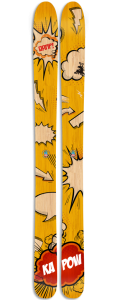Park City, UT – RAMP Sports (Riders Artists Musicians Project) has announced its winter 2012-13 line of handmade skis which will feature a performance-enhancing layer of Kevlar for vibration dampening. RAMP is the first ski company to use Kevlar, widely recognized for its use in bulletproof vests, throughout its entire line of expert/advanced skis that this season will be manufactured stateside in the company’s own facility in Park City.
While the skis may not be truly bullet-resistant, Kevlar increases the performance of the ski through drastically increased vibration dampening, says RAMP CEO and founder, Mike Kilchenstein. Five times stronger than steel but at a fraction of the weight, Kevlar also resists stretching and creates greater rebound energy when the ski flexes, resulting in what Kilchenstein says is an incredibly responsive, playful, mid-weight ski.

“Kevlar offers many benefits not available with traditional fiberglass construction,” Kilchenstein asserts. “Kevlar has an impressive strength-to-weight ratio, while still maintaining great flexibility. Our testing tells us it’s well worth our additional cost to make skis that really make people happy, day in and day out.”
A former executive with Rossignol North America managing its Roxy ski line, Kilchenstein launched RAMP in December 2010 with a consumer direct sales model at factory-direct pricing previously attempted by only a handful of small boutique ski manufacturers.
“The business model is broken,” Kilchenstein says when describing the distribution system employed by the ski industry’s biggest players. “The consumer wants a closer relationship with the supplier, they want to be able to access the product more easily and more directly, and communicate with the people they buy through. We created a whole new business model in that industry.”
Kilchenstein has since expanded distribution to also include a handful of resort-based brick-and-mortar retailers. RAMP is now again bucking ski industry norms by returning its manufacturing from contract plants in China to its own new factory in Park City, Utah.
“We could never find factories that have enough bandwidth to do the kinds of development that we want them to do, and they don’t have enough variety of shapes and constructions,” Kilchenstein says.
What’s striking is that the company’s new Park City plant doesn’t contain a single press like those employed in traditional ski manufacturing. RAMP is instead making skis and snowboards by utilizing a vacuum molding process similar to that employed in the manufacture of items such as helicopter blades. Kilchenstein points out that this means that during research and development, the company can make minor modifications to camber and sidecut without creating a new mold each time.
“We can go to Mount Hood and do a test and come back and say, ‘That ski has just a little too much sidecut, or not quite enough sidecut,’ and change it the next day,” he says.
Kilchenstein illustrates other benefits to vacuum molding, including a more natural camber and flex to the ski, and a cleaner manufacturing process with less material waste. In fact, Kilchenstein is committed to green business practices wherever possible.
“We ship people their skis and their snowboards in a padded bag instead of a box, for instance, so we get rid of thousands of boxes,” he cites. “We buy 300 pounds of carbon offset with every ski and board we sell through Native Energy. We buy back any old ski or snowboard and give people a $50 credit to take them out of landfills and use them for things like furniture.”
RAMP’s new skis employing Kevlar are now available now for direct purchase at www.RampSports.com and at a limited number of select retailers. And with their direct-to-consumer sales model, expect to see their demo tent at a resort near you this winter for the opportunity to test drive their vacuum-molded, American-made skis for yourself.

